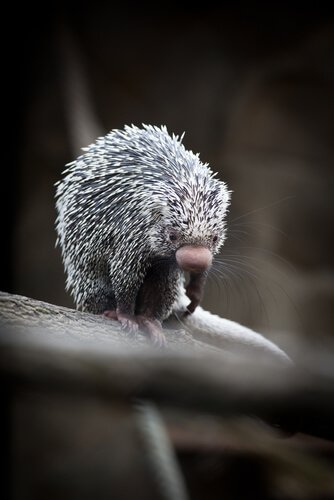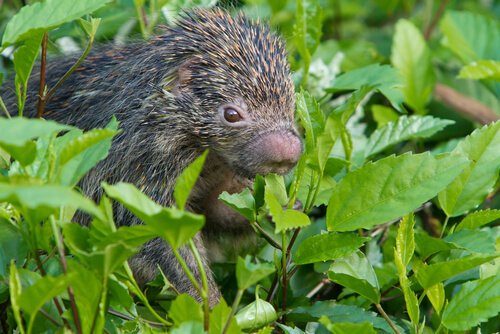Meet the adorable prehensile tail porcupine
The prehensile tail porcupine is one of the 12 porcupine species of the so-called New World . They are endemic to the South American forests of Venezuela, Guyana, Brazil, Bolivia, Paraguay and some sections of the extreme north of Argentina.
These animals are excellent climbers and spend most of their time in trees Like many nocturnal animals, the prehensile-tailed porcupine has poor eyesight, but has very sharp senses of touch, hearing and smell.
Certain mammals and birds of prey may try to attack a prehensile tail porcupine. , but usually it does not end well for the predator. This species defends itself with great success by being able to growl, lean and shake its spines to intimidate the predator.
Prehensile tail porcupine morphology
Adult individuals can measure up to 60 centimeters in length and weigh up to five kilos . The tail is almost as long as your body, and that adds between 33 and 48 inches more in total. The prehensile tails are used for stabilization and grip during climbing, as well as for hanging.
This species of porcupine has short and thick quills, which give it a mottled appearance. Thorns are usually flat, but stand up when the animal feels threatened . These vary in color from cream to yellow, to brown and almost black.

The color of the skin is similar to that of the barbs, with a yellow-orange tone . This tonality is due to a waxy and spicy substance exuded from the sebaceous glands of males and females. The semi-hollow thorns of 60 to 100 millimeters in length are effective to penetrate the flesh of predators and are very difficult to eliminate.
Reproduction habits
There is little documentation about of the reproductive system of this species . In captivity it has been possible to observe cases of males urinating on females and their young to mark them. This is done once during the courtship period and once when the baby is born.
The females reach sexual maturity around 19 months of age and may continue to be reproductive up to 12 years of age. The gestation period lasts approximately 203 days. The baby usually weighs about 400 grams, is born with open eyes and is able to climb.
Weaning occurs around 10 weeks of age , but the animal will not reach its maximum size until about 48 weeks.
The sexual organs of the prehensile tail porcupine are internal , so scientists used to spend up to six months before being able to identify them. Hence they have decided to use an innovative DNA analysis technique extracted from a spike to determine sex.
Feeding and behavior
The prehensile tail porcupine is herbivore . Enjoy the leaves, buds, flowers, roots and the cambium layer found under the bark of some trees. In general, they feed themselves or in pairs, never in groups.

It is nocturnal, so it usually sleeps during the day and, at nightfall, goes out to look for food . They move slowly but easily between the trees. Normally, they descend to the ground only when they can not cover a gap between the trees or to mate and defecate.
The prehensile tail porcupine is socially tolerant , especially when the pairs and the Food are plentiful. However, they prefer small groups or totally lonely lifestyles.Long moans, screams, grunts, whistles and squeaks are the main auditory communications. The grinding of the teeth, the posture and the rattle of the spines are used against possible threats.
When they are relaxed and comfortable, the tines rest flat against the skin . If an unknown individual threatens them, irritates them or confronts them, they will remain erect. To look even bigger and more dangerous in the face of a threat, these animals will exhibit the thorns. The velocity of piloerection can indicate the intensity of the threat or perceived discomfort.
Life expectancy
The life expectancy of the porcupine tail prehensile under human care ranges between 12 and 17 years old This species is not listed as threatened or endangered . However, they are frequently displaced by habitat loss and in some regions they are killed by hunters.


